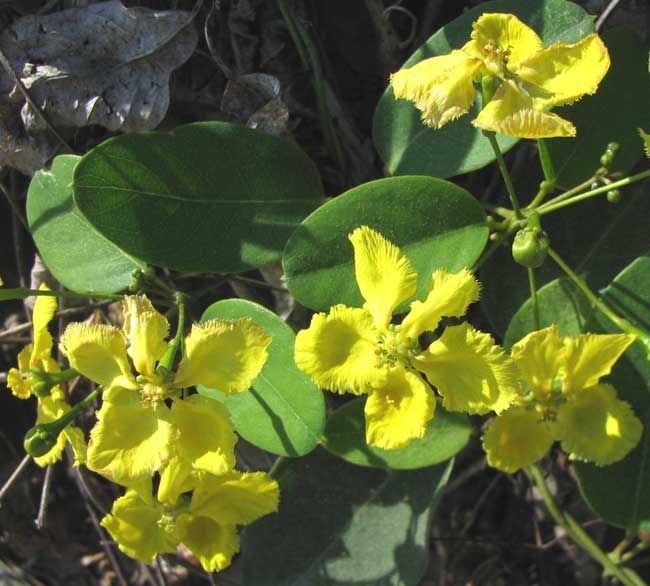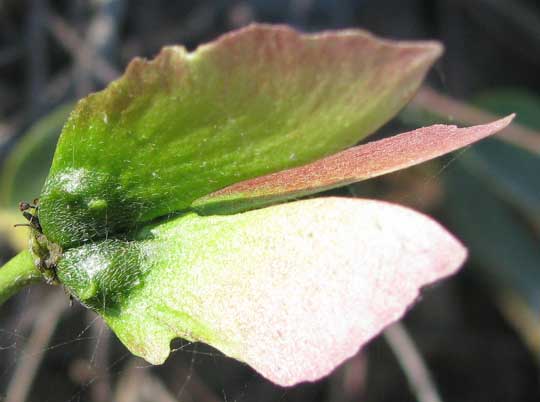Excerpts from Jim Conrad's
Naturalist Newsletter

from the February 13, 2011 Newsletter issued from Hacienda Chichen Resort beside Chichén Itzá Ruins, central Yucatán, MÉXICO; limestone bedrock, elevation ~39m (~128ft), ~N20.676°, ~W88.569°
STIGMAPHYLLON VINE ON A STONE WALL
While biking Pisté's backstreets you just never know what you'll find. This week it was a small, fragile looking vine with yellow flowers, the one shown above. A flower is shown close-up below:

We've seen flowers very similar to this before -- flowers with ping-pong-paddle-shaped petals, and with those pairs of curious, green, oval things between the petal bases. For example, there was the Barbados- Cherry, whose pinkish flower still resides at www.backyardnature.net/n/09/091122mq.jpg.
And there was the Nance, whose yellow flower is seen at www.backyardnature.net/n/09/091206nd.jpg.
Those two species are important fruit trees in the tropics and both are members of the big, tropical Malpighia Family, the Malpighiaceae. While the Malpighia Family is important in the tropics, in the Temperate Zone it's practically unknown. Weakley's hefty Flora of the Southern and Mid-Atlantic States doesn't list a single species in the Malpighia Family.
Our Pisté wall vine is a member of the Malpighia Family. It's STIGMAPHYLLON ELLIPTICUM, occurring from tropical Mexico to at least as far south as Panamá.
The best field mark for the family is that each sepal on each flower bears two conspicuous, oval glands, and that's what we're seeing between the petal bases. Also, most members of the family bear opposite leaves -- two leaves per stem node -- and typically the leaves or petioles bear glands like those shown below:

In that picture the tiny, silvery hairs on the stems also are distinctive for the family, though we'd need greater magnification to see them. The hairs are attached to the surface they grow from at their middles, so that each hair has two free, sharp ends. Such hairs are said to be "malpighian hairs" because they're so typical of the Malpighia Family.
Our little vine also bore fruits, which are shown below:

Those are samara-type fruits, like those of maples and ashes, which means that they are winged fruits that don't split open when mature. You may recall the Heteropteris brachiata in this January 9th's Newsletter with very similar fruits, as shown at www.backyardnature.net/yucatan/heteropt.htm.
That vine also was a member of the Malpighia Family, and the big difference between the present fruits and those is that Heteropteris's wings had stiff ribs on the side facing away from the cluster's center, while our current Stigmaphyllon fruit wing ribs face the inside.
Knowing little details like this just tickle a naturalist. It's the "variation on a theme" thing.